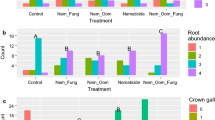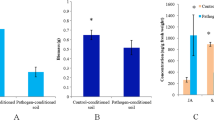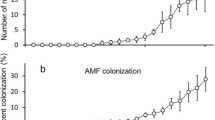Abstract
Root development may exert control on plant–pathogen interactions with soil-borne pathogens by shaping the spatial and temporal availability of susceptible tissues and in turn the impact of pathogen colonization on root function. To evaluate the relationship between root development and resistance to apple replant disease (ARD) pathogens, pathogen abundance was compared across root branching orders in a bioassay with two rootstock genotypes, M.26 (highly susceptible) and CG.210 (less susceptible). Root growth, anatomical development and secondary metabolite production were evaluated as tissue resistance mechanisms. ARD pathogens primarily colonized first and second order roots, which corresponded with cortical tissue senescence and loss in second and third order roots. Defense compounds were differentially allocated across root branching orders, while defense induction or stress response was only detected in first order and pioneer roots. Our results suggest disease development is based largely on fine-root tip attrition. In accordance, the less susceptible rootstock supported lower ARD pathogen abundance and altered defense compound production in first order and pioneer roots and maintained higher rates of root growth in both the ARD soil and pasteurized control compared to the more susceptible. Thus, this rootstock’s ability to maintain shoot growth in replant soil may be attributable to relative replant pathogen resistance in distal root branches as well as tolerance of infection based on rates of root growth.







Similar content being viewed by others
References
Abramoff MD, Magalhaes PJ, Ram SJ (2004) Image processing with ImageJ. Biophotonics Int 11:36–42
Alt D, Schmidle A (1980) Untersuchungen uber mögliche Resistenzfaktoren des Apfels gegen Phytophthora cactorum (Leb. et Cohn) Schroet. Angewandte Botanik 54:139–156
Bauerle TL, Eissenstat DM, Granett J, Gardner DM, Smart DR (2007) Consequences of insect herbivory on grape fine root systems with different growth rates. Plant Cell Environ 30:786–795
Bednarek P, Osbourn A (2009) Plant-microbe interactions: chemical diversity in plant defense. Science 324:746–748
Bennett RN, Wallsgrove RM (1994) Tansley Review No. 72. Secondary metabolites in plant defence mechanisms. New Phytol 127:617–633
Bent E, Loffredo A, Yang J-I, McKenry MV, Becker JO, Borneman J (2009) Investigations into peach seedling stunting caused by a replant soil. FEMS Microbiol Ecol 68:192–200
Braun PG (1995) Effects of Cylindrocarpon and Pythium species on apple seedlings and potential role in apple replant disease. Can J Plant Pathol 17:336–341
Chaverri P, Salgado C, Hirooka Y, Rossman AY, Samuels GJ (2011) Delimitation of (Neonectria and Cylindrocarpon Nectriaceae, Hypocreales, Ascomycota) and related genera with Cylindrocarpon-like anamorphs. Stud Mycol 68:57–78
Eissenstat DM, Achor DS (1999) Anatomical characteristics of roots of citrus rootstocks that vary in specific root length. New Phytol 141:309–321
Eissenstat DM, Wells CE, Yanai RD, Whitbeck JL (2000) Building roots in a changing environment: implications for root longevity. New Phytol 147:33–42
English JT, Mitchell DJ (1988) Relationships between the development of root systems of tobacco and infection by Phytophthora parasitica var. nicotianae. Phytopathology 78:1478–1483
English JT, Mitchell DJ (1989) Use of morphometric analysis for characterization of tobacco root growth in relation to infection by Phytophthora parasitica var. nicotianae. Plant Soil 113:243–249
Enstone DE, Peterson CA, Ma FS (2002) Root endodermis and exodermis: structure, function, and responses to the environment. J Plant Growth Reg 21:335–351
Esau K (1965) Plant anatomy, 2nd edn. Wiley, New York
Fitter AH (1982) Morphometric analysis of root systems: application of the technique and influence of soil fertility on root-system development in two herbaceous species. Plant Cell Environ 5:313–322
Gosch C, Halbwirth H, Stich K (2010) Phloridzin: biosynthesis, distribution and physiological relevance in plants. Phytochemistry 71:838–843
Guo D, Xia M, Wei X, Chang W, Liu Y, Wang Z (2008) Anatomical traits associated with absorption and mycorrhizal colonization are linked to root branch order in twenty-three Chinese temperate tree species. New Phytol 180:673–683
Hishi T (2007) Heterogeneity of individual roots within the fine root architecture: causal links between physiological and ecosystem functions. J For Res 12:126–133
Hofmann A, Wittenmayer L, Arnold G, Schieber A, Merbach W (2009) Root exudation of phloridzin by apple seedlings (Malus × domestica Borkh.) with symptoms of apple replant disease. J Appl Bot Food Qual-Angewandte Botanik 82:193–198
Højsgaard S, Halekoh U, Yan J (2006) The R package geepack for generalized estimating equations. J Stat Softw 15(2):1–11
Isutsa DK, Merwin IA (2000) Malus germplasm varies in resistance or tolerance to apple replant disease in a mixture of New York orchard soils. HortScience 35:262–268
Jaffee BA, Abawi GS, Mai WF (1982a) Fungi associated with roots of apple seedlings grown in soil from an apple replant site. Plant Dis 66:942–944
Jaffee BA, Abawi GS, Mai WF (1982b) Role of soil microflora and Pratylenchus penetrans in an apple replant disease. Phytopathology 72:247–251
Jönsson U (2006) A conceptual model for the development of Phytophthora disease in Quercus robur. New Phytol 171:55–68
Leinfelder MM, Merwin IA (2006) Rootstock selection, preplant soil treatments, and tree planting positions as factors in managing apple replant disease. HortScience 41:394–401
Mai WF, Abawi GS (1981) Controlling replant diseases of pome and stone fruits in northeastern United States by pre-plant fumigation. Plant Dis 65:859–864
Mazzola M (1998) Elucidation of the microbial complex having a causal role in the development of apple replant disease in Washington. Phytopathology 88:930–938
Mazzola M, Brown J, Zhao XW, Izzo AD, Fazio G (2009) Interaction of brassicaceous seed meal and apple rootstock on recovery of Pythium spp. and Pratylenchus penetrans from roots grown in replant soils. Plant Dis 93:51–57
McCall AC, Fordyce JA (2010) Can optimal defence theory be used to predict the distribution of plant chemical defences? J Ecol 98:985–992
McGarigal K, Cushman S, Stafford S (2000) Multivariate statistics for wildlife and ecology research. Springer, New York
McKey D (1974) Adaptive patterns in alkaloid physiology. Am Nat 108:305–320
Noyer C, Thomas OP, Becerro MA (2011) Patterns of chemical diversity in the mediterranean sponge Spongia lamella. PLoS One 6:e20844
Oksanen J, Blanchet FG, Kindt R, Legendre P, Minchin PR, O’Hara RB, Simpson GL, Solymos P, Stevens MHH, Wagner H (2012) vegan: Community Ecology Package, R package version 2.0-3. http://CRAN.R-project.org/package=vegan
Packer A, Clay K (2003) Soil pathogens and Prunus serotina seedling and sapling growth near conspecific trees. Ecology 84:108–119
Petkovsek MM, Stampar F, Veberic R (2009) Seasonal changes in phenolic compounds in the leaves of scab-resistant and susceptible apple cultivars. Can J Plant Sci 89:745–753
Pregitzer KS, DeForest JL, Burton AJ, Allen MF, Ruess RW, Hendrick RL (2002) Fine root architecture of nine North American trees. Ecol Monogr 72:293–309
R Development Core Team (2012) R: A language and environment for statistical computing. R Foundation for Statistical Computing, Vienna
Reinhart KO, Clay K (2009) Spatial variation in soil-borne disease dynamics of a temperate tree, Prunus serotina. Ecology 90:2984–2993
Sambrook J, Fritsch EF, Maniatis T (1989) Molecular cloning: a laboratory manual. Cold Spring Harbor Laboratory, New York
Tewoldemedhin YT, Mazzola M, Botha WJ, Spies CFJ, McLeod A (2011a) Characterization of fungi (Fusarium and Rhizoctonia) and oomycetes (Phytophthora and Pythium) associated with apple orchards in South Africa. Eur J Plant Path 130:215–229
Tewoldemedhin YT, Mazzola M, Labuschagne I, McLeod A (2011b) A multi-phasic approach reveals that apple replant disease is caused by multiple biological agents, with some agents acting synergistically. Soil Biol Biochem 43:1917–1927
Tewoldemedhin YT, Mazzola M, Mostert L, McLeod A (2011c) Cylindrocarpon species associated with apple tree roots in South Africa and their quantification using real-time PCR. Eur J Plant Pathol 129:637–651
Watt M, Silk WK, Passioura JB (2006) Rates of root and organism growth, soil conditions, and temporal and spatial development of the rhizosphere. Ann Bot 97:839–855
Wells CE, Eissenstat DM (2002) Beyond the roots of young seedlings: the influence of age and order on fine root physiology. J Plant Growth Regul 21:324–334
Wilcox HE (1968) Morphological studies of the root of red pine, Pinus resinosa I. Growth characteristics and patterns of branching. Am J Bot 55:247–254
Yao SR, Merwin IA, Brown MG (2006) Root dynamics of apple rootstocks in a replanted orchard. HortScience 41:1149–1155
Zadworny M, Eissenstat DM (2011) Contrasting the morphology, anatomy and fungal colonization of new pioneer and fibrous roots. New Phytol 190:213–221
Acknowledgments
We would like to thank John Zhao and Meghan Horne for the many hours of help with sampling and processing materials, Rayko Halitschke (Cornell University) for assistance with the HPLC analysis, and North American Plants, LLC, Gennaro Fazio (USDA-ARS) and Herb Aldwinkle (Cornell University) for providing explants in tissue culture and thank Mark Mazzola (USDA-ARS) for providing the Rhizoctonia AG-5 culture. Alex Paya (Cornell University) provided line drawings for Fig. 7. This research was supported in part by the Cornell University Agricultural Experiment Station federal formula funds, Project No. NYC-448 received from the National Institutes for Food and Agriculture (NIFA), US Department of Agriculture, and the Cornell University Arthur Boller Fund. Any opinions, findings, conclusions, or recommendations expressed in this publication are those of the authors and do not necessarily reflect the view of the US Department of Agriculture.
Conflict of interest
The authors declare no conflict of interest.
Author information
Authors and Affiliations
Corresponding author
Electronic supplementary material
Below is the link to the electronic supplementary material.
Rights and permissions
About this article
Cite this article
Emmett, B., Nelson, E.B., Kessler, A. et al. Fine-root system development and susceptibility to pathogen colonization. Planta 239, 325–340 (2014). https://doi.org/10.1007/s00425-013-1989-7
Received:
Accepted:
Published:
Issue Date:
DOI: https://doi.org/10.1007/s00425-013-1989-7




